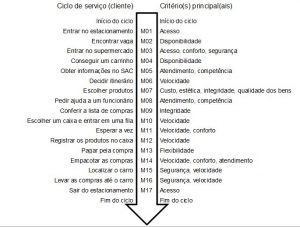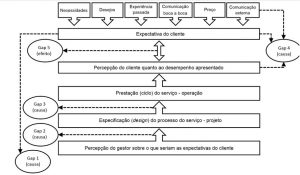By Guilherme Almeida *
Talk about quality in services It is talking about customers (internal and external). And being the customer the most important point of service, it is imperative here to define quality.
The company must be careful, especially with regard to serving its customers, a very important factor that has direct consequences on quality. However, we cannot help but admit how the #8220; quality is a subjective item & #8221; for a customer & #8220; a delivery & #8221; can be of good quality while for others not.
But how does customer satisfaction level form? One of the most accepted models It is what determines the degree of customer satisfaction as the comparison between the expectation that the customer has before using the service and the perception of the quality of the service provided.
This article aims to present 3 easy to implement tools that raise the service quality delivered to customer:
Moments of Truth
The expression “moment of truth” was proposed by Normann (1993) and defines that there are crucial moments for customer perception and satisfaction. Satisfaction results from the various perceptions that the customer accumulates during a sequence of moments of contact with the service.
During the service cycle, it is possible to identify the most relevant competitive criteria in customer expectations. Consider, for example, providing a trip to a supermarket, as shown in Figure 1. At each moment of truth (denoted by Mi, where i is the ith moment of truth), the customer has some expectation about performance criteria (examples: access, speed, consistency, competence, service, security, flexibility, comfort, cleanliness, aesthetics, cost, integrity), and the sum of these expectations will form the degree of customer satisfaction.

Figure 1 & #8211; Duty cycle from a trip to the supermarket.
5 GAP Quality Model
Proposed by Zeithaml in 1990, the 5-gap quality model joins the expectations formation model with the perception formation model, as shown in Figure 2.
The 5 gaps are defined as follows:
GAP 1 - Failure to compare consumer expectation - managerial perception. Gap 1 is the difference between the service expected by the customer and what Customer Perceptions and Expectations Management found as the customer's desire.
GAP 2 - Failure to compare managerial perception - specification of quality of service. Gap 2 is the difference between what Customer Perceptions and Expectations Management has found as customer desire and quality of service specification.
GAP 3 - Failed to compare service specification - service provision. Gap 3 is the difference between the specification of service quality and service actually delivered.
GAP 4 - Failed to compare service specification - external communication with customer. Gap 4 is the difference between the specified quality of service and what the company communicates externally.
GAP 5 - Failed to compare customer expectation - customer perception. Gap 5 is the difference between what the customer expects and what the company actually delivers to it. This gap results from the occurrence of type 1 to 4 faults, either alone or in combination.

Figure 2 & #8211; 5 model GAPs
NPS
In 2003, Frederick F. Reichheld published in Harvard Business Review an article titled "Will Your Customers Save or Betray You?" In this article, Reichheld has developed a simple yet effective way to measure the health of the relationship between companies and their customers. By asking the question “on a scale from 0 to 10, how much would you refer this company to a friend?” One can find out the list of customers who would refer the company and the portion that would not - and thus those who are. satisfied and those who are dissatisfied. This result is known as NPS - Net Promoter Score.
Reichheld's question classifies customers into three groups. The detractors are those customers who answer with a score between 0 and 6; They are dissatisfied customers who would not indicate the company and can damage its reputation. The neutral are customers who respond with a score of 7 or 8; They are usually satisfied customers, but indifferent to the company and can easily be seduced by the competition. Customers who grade 9 or 10 are the promoters. These are the loyal customers who will continue to buy and recommend the company to others.
The final SPN value is calculated by subtracting the percentage of detractors from the percentage of promoters, as shown in Figure 3.

Figure 3 - NPS calculation
From the NPS score you can classify organizations into four Rating Zones, which exemplify how well the company is in customer satisfaction:
1) Zone of excellence: Score between 75 and 100. Companies ranked in this zone have generated great customer experiences, which should become good recommendations for other potential customers;
2) Quality zone: Scores between 50 and 74. Companies in this scoring range have generated good customer experiences with some flaws. These companies must reevaluate the customer journey;
3) Improvement Zone: Score between 0 and 49. Experience provided in this SPL range points to adjustment points. In most cases, the customer did not perceive the company's adherence to their needs - or, in the worst case, perceived the company as inefficient.
4) Critical Zone: score between -100 and -1. In this range of NPS, the customer experience was extremely frustrating. Customers will not recommend the company and will blacken its image. A company in this rank should review its goals and strategy quickly.
Conclusion
THE quality management in services It has become a growing concern for all service providers in recent years - in particular in the area of Information Security. Three easy-to-implement tools that raise the quality perceived by the end customer, whether internal or external, were presented. These tools should be used continuously in order to gradually increase the maturity of the quality of services provided.
* Guilherme Almeida is Cyber Security Manager Safeway Consulting.
Regarding the [SAFEWAY]
SAFEWAY is an Information Security company, recognized by its customers for offering high value added solutions through Information Security projects that fully meet business needs. During these years of experience, we have proudly accumulated several successful projects that have earned us credibility and prominence in our clients, which constitute in large part the 100 largest companies in Brazil.
Today through more than 17 strategic partnerships with global manufacturers and our SOC, SAFEWAY is considered a one stop shopping with the best technology solutions, processes and people.
Let's make the world a safer place to live and do business!




